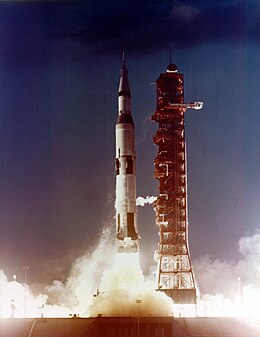
Back Apollo 4 AF أبولو 4 Arabic Apollon 4 AZ Аполо 4 Bulgarian অ্যাপোলো ৪ Bengali/Bangla Apollo 4 Catalan Apollo 4 Czech Apollo 4 German Απόλλων 4 Greek Apolo 4 Spanish
 The first flight of a Saturn V launch vehicle | |
| Mission type | Uncrewed Earth orbital CSM flight (A) |
|---|---|
| Operator | NASA |
| COSPAR ID | 1967-113A (command and service modules) 1967-113B (S-IVB)[1] |
| SATCAT no. | 3032 |
| Mission duration | 8 hours, 36 minutes, 59 seconds |
| Orbits completed | 3 |
| Spacecraft properties | |
| Spacecraft | Apollo CSM-017 Apollo LTA-10R |
| Manufacturer | North American Rockwell |
| Launch mass | 36,856 kilograms (81,253 lb) |
| Start of mission | |
| Launch date | November 9, 1967, 12:00:01 UTC |
| Rocket | Saturn V SA-501 |
| Launch site | Kennedy LC-39A |
| End of mission | |
| Recovered by | USS Bennington |
| Landing date | November 9, 1967, 20:37:00 UTC |
| Landing site | North Pacific Ocean 30°06′N 172°32′W / 30.100°N 172.533°W |
| Orbital parameters | |
| Reference system | Geocentric |
| Regime | Highly elliptical orbit |
| Perigee altitude | −204 kilometers (−110 nmi) |
| Apogee altitude | 18,092 kilometers (9,769 nmi) |
| Inclination | 31.9 degrees |
| Period | 314.58 minutes (initial) |
| Epoch | November 9, 1967[2] |
Apollo 4 (November 9, 1967), also known as SA-501, was the uncrewed first test flight of the Saturn V launch vehicle, the rocket that eventually took astronauts to the Moon. The space vehicle was assembled in the Vehicle Assembly Building, and was the first to be launched from Kennedy Space Center (KSC) in Florida, ascending from Launch Complex 39, where facilities built specially for the Saturn V had been constructed.
Apollo 4 was an "all-up" test, meaning all rocket stages and spacecraft were fully functional on the initial flight, a first for NASA. It was the first time the S-IC first stage and S-II second stage flew. It also demonstrated the S-IVB third stage's first in-flight restart. The mission used a Block I command and service module modified to test several key Block II revisions, including its heat shield at simulated lunar-return velocity and angle.
The launch was planned for early 1967, but delayed to November 9 because of problems with various elements of the spacecraft and difficulties during pre-flight testing. Additional inspections were also required after a fire killed the Apollo 1 crew in January 1967.
The mission splashed down in the Pacific Ocean slightly less than nine hours after launch, having achieved its objectives. NASA considered the mission a complete success, proving that the Saturn V worked, an important step towards achieving the main objective of landing astronauts on the Moon, and bringing them back safely, before the end of the 1960s.
- ^ Orloff & Harland 2006, p. 124.
- ^ McDowell, Jonathan. "Master Satellite List". Jonathan's Space Pages. Retrieved March 23, 2014.